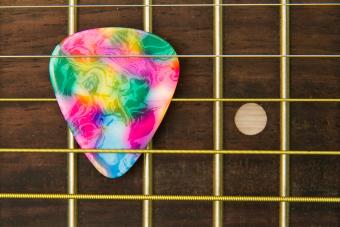
Scales on bass guitar, like chords on regular guitar, are the foundation for each key in which you play. In addition, scales provide an excellent workout and a way to become accustomed to moving around on the bass guitar fingerboard. The scales presented here are major scales. Major scales consist of eight notes that follow a pattern of W W H W W W H, where W stands for whole step (two frets) and H stands for half step (one fret).
Organization of the Scales
Each scale is written using bass tabs and regular music notation. If you are familiar with bass tabs, you should have no trouble playing the top part.
All accidentals (flats and sharps) are marked. Scales are written both ascending (going up) and descending (going down). It is important to learn to play scales ascending and descending to facilitate your familiarity with the fingerboard.
C Major Scale

Following the tab diagram (top line above), start by pressing down on the A string (second string down on the bass guitar) on the 3rd fret. Play that note, C. C is the first note of the C Major scale.
Follow with the note D, played by plucking the open D string. The next note, E, is played by pressing down the D string at the 2nd fret.
F is next, played on the D string, 3rd fret. This is followed by G, which is the bottom or G string played open. Then comes A, played on the G string, 2nd fret, followed by B, played on the G string 4th fret, and finally C, which is played on the G string, 5th fret.
Congratulations. You have just played a C Major scale!
Below the tab diagram there is a music staff with all notes marked. If regular music notation is new to you, these scale exercises provide a handy way for you to begin to understand music written in this way. If tabs are unfamiliar but you can read notation, the notes can serve as a guide to learning how to read music written using tabs.
For each of the other major scales, follow the tablature diagram as you did above. Remember that the numbers refer to the fret, not to the fingers used. Also, make sure when you press down on a fret you do so close to the metal bar to make the sound as crisp and clean as possible.
G Major Scale

D Major Scale

A Major Scale

E Major Scale

F Major Scale

Bb Major Scale

Eb Major Scale

Ab Major Scale

Final Six Scales
When you get to the final six scales you will notice something unusual about them. Although there are six scales, only three of them actually sound different. That's because every other scale is enharmonic, meaning the note names are different but sound the same.
The B and Cb Major scales sound the same, the F# and Gb Major scales sound the same, and the C# and Db Major scales sound the same.
Check out the note names under each scale. You will see that the first note of the B scale, B, sounds the same as the first note of the Cb scale, Cb. Those two notes are enharmonic.
Also, note that the tabs for each set of two enharmonic scales are exactly the same. That's because in each case you are playing the same notes, just with different names.
B Major/Cb Major Scales


F# Major/Gb Major Scales


C# Major/Db Major Scales


For More Advanced Players
The diagram below shows all four strings on the bass guitar and the notes associated with the open string and first ten frets. It's possible to play major scales using different combinations of strings and frets.
For example, try playing a C Major scale by starting on the E string 8th fret (C), followed by the E string 10th fret (D), then A string 7th fret (E), A string 8th fret (F), A string 10th fret (G), D string 7th fret (A), D string 9th fret (B), and finally D string 10th fret (C).
---G---|---G#/Ab---|---A---|---A#/Bb---|---B---|---C---|---C#/Db---|---D---|---D#/Eb---|---E---|---F---|
---D---|---D#/Eb---|---E---|---F---|---F#/Gb--|---G---|---G#/Ab---|---A---|---A#/Bb---|---B----|---C---|
---A---|---A#/Bb---|---B---|---C---|---C#/Db--|---D---|---D#/Eb---|---E---|---F----|---F#/Gb---|---G---|
---E---|----F----|---F#/Gb--|---G---|---G#/Ab--|---A---|---A#/Bb---|---B---|---C----|---C#/Db---|---D---|
By using the scale note names as a guide, you can play major scales in different positions on the fingerboard, thereby learning any number of ways to play the same notes.
Get Moving with Scales
Playing scales on any instrument provides a great warm-up activity, getting your fingers moving and ready for more intricate work. Playing scales can also help you ensure that your bass guitar is in tune.







